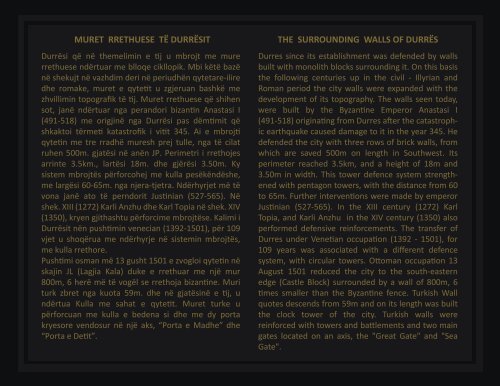Broshura me sitet Arkeologjike dhe monumentet e trashegimise kulturore
You also want an ePaper? Increase the reach of your titles
YUMPU automatically turns print PDFs into web optimized ePapers that Google loves.
MURET RRETHUESE TË DURRËSIT<br />
Durrësi që në the<strong>me</strong>limin e tij u mbrojt <strong>me</strong> mure<br />
rrethuese ndërtuar <strong>me</strong> blloqe cikllopik. Mbi këtë bazë<br />
në shekujt në vazhdim deri në periudhën qytetare-ilire<br />
<strong>dhe</strong> romake, muret e qytetit u zgjeruan bashkë <strong>me</strong><br />
zhvillimin topografik të tij. Muret rrethuese që shihen<br />
sot, janë ndërtuar nga perandori bizantin Anastasi I<br />
(491-518) <strong>me</strong> origjinë nga Durrësi pas dëmtimit që<br />
shkaktoi tër<strong>me</strong>ti katastrofik i vitit 345. Ai e mbrojti<br />
qytetin <strong>me</strong> tre rradhë muresh prej tulle, nga të cilat<br />
ruhen 500m. gjatësi në anën JP. Peri<strong>me</strong>tri i rrethojes<br />
arrinte 3.5km., lartësi 18m. <strong>dhe</strong> gjërësi 3.50m. Ky<br />
sistem mbrojtës përforcohej <strong>me</strong> kulla pesëkëndëshe,<br />
<strong>me</strong> largësi 60-65m. nga njera-tjetra. Ndërhyrjet më të<br />
vona janë ato të perndorit Justinian (527-565). Në<br />
shek. XIII (1272) Karli Anzhu <strong>dhe</strong> Karl Topia në shek. XIV<br />
(1350), kryen gjithashtu përforci<strong>me</strong> mbrojtëse. Kalimi i<br />
Durrësit nën pushtimin venecian (1392-1501), për 109<br />
vjet u shoqërua <strong>me</strong> ndërhyrje në sistemin mbrojtës,<br />
<strong>me</strong> kulla rrethore.<br />
Pushtimi osman më 13 gusht 1501 e zvogloi qytetin në<br />
skajin JL (Lagjia Kala) duke e rrethuar <strong>me</strong> një mur<br />
800m, 6 herë më të vogël se rrethoja bizantine. Muri<br />
turk zbret nga kuota 59m. <strong>dhe</strong> në gjatësinë e tij, u<br />
ndërtua Kulla <strong>me</strong> sahat e qytetit. Muret turke u<br />
përforcuan <strong>me</strong> kulla e bedena si <strong>dhe</strong> <strong>me</strong> dy porta<br />
kryesore vendosur në një aks, “Porta e Ma<strong>dhe</strong>” <strong>dhe</strong><br />
“Porta e Detit”.<br />
THE SURROUNDING WALLS OF DURRËS<br />
Durres since its establish<strong>me</strong>nt was defended by walls<br />
built with monolith blocks surrounding it. On this basis<br />
the following centuries up in the civil - Illyrian and<br />
Roman period the city walls were expanded with the<br />
develop<strong>me</strong>nt of its topography. The walls seen today,<br />
-<br />
ic earthquake caused damage to it in the year 345. He<br />
defended the city with three rows of brick walls, from<br />
which are saved 500m on length in Southwest. Its<br />
peri<strong>me</strong>ter reached 3.5km, and a height of 18m and<br />
3.50m in width. This tower defence system strengthened<br />
with pentagon towers, with the distance from 60<br />
Topia, and Karli Anzhu in the XIV century (1350) also<br />
perfor<strong>me</strong>d defensive reinforce<strong>me</strong>nts. The transfer of<br />
109 years was associated with a different defence<br />
August 1501 reduced the city to the south-eastern<br />
edge (Castle Block) surrounded by a wall of 800m, 6<br />
quotes descends from 59m and on its length was built<br />
the clock tower of the city. Turkish walls were<br />
gates located on an axis, the "Great Gate" and "Sea<br />
Gate".




